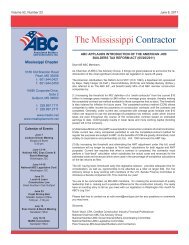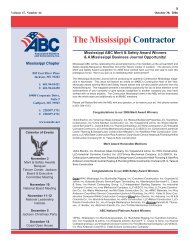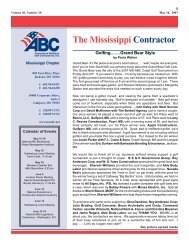§1904.766immediate recording of significant disorders on firstdiagnosis. Many occupational illnesses manifestthemselves through gradual onset and worsening ofthe condition. In some cases, a worker could be diagnosedwith a significant illness, such as an irreversiblerespiratory disorder, not be given medicaltreatment because no effective treatment was available,not lose time from work because the illness wasnot debilitating at the time, and not have his or hercase recorded on the Log because none of therecording criteria had been met. If such a worker leftemployment or changed employers before one of theother recording criteria had been met, this seriousoccupational illness case would never be recorded.The requirements in paragraph 1904.7(b)(7) remedythis deficiency and will thus ensure the capture ofmore complete and timely data on these injuries andillnesses….<strong>OSHA</strong> agrees with those commenters who supportedthe inclusion in the final rule of an additionalmechanism to ensure the capture of significant workrelatedinjuries and illnesses that are diagnosed by aphysician or other licensed health care professionalbut do not, at least at the time of diagnosis, meet thecriteria of death, days away from work, restrictedwork or job transfer, medical treatment beyond firstaid, or loss of consciousness. The recording of allnon-minor injuries and illnesses is consistent withthe OSH Act (see the Legal Authority section) and hasbeen the intent of the recordkeeping system formany years. The primary goal of the requirement atparagraph 1904.7(b)(7) is to produce more accurateand complete data on non-minor work-relatedinjuries and illnesses. Because the number of significantwork-related injuries and illnesses may not becaptured by one or more of the other general recordingcriteria, <strong>OSHA</strong> finds that this additional criterionis needed. However, <strong>OSHA</strong> believes that most caseswill be captured by the general recording criteria…....[T]o address the gap in case capture presentedby significant injury and illness cases that escape thegeneral recording criteria, <strong>OSHA</strong> is requiring employersto record cases of chronic, irreversible diseaseunder the Section 1904.7(b)(7) criterion. This meansthat if long-term workplace exposure to anilineresults in a chronic, irreversible liver or kidney disease,the case would be recordable at the time ofdiagnosis, even if no medical treatment is administeredat that time and no time is lost from work. Theregulatory text of paragraph 1904.7(b)(7) limits thetypes of conditions that are recordable, however, tosignificant diagnosed injury and illness cases, whichare defined as cancer, chronic irreversible diseases,fractured or cracked bones, and punctured eardrums.<strong>OSHA</strong> RECORDKEEPINGHow Should the Agency Define “Significant” Injuryor Illness?...<strong>OSHA</strong> believes that the conditions that are requiredto be recorded under Section 1904.7(b)(7) of the finalrule represent significant occupational injuries and illnessesas described in the OSH Act. Some clearlysignificant injuries or illnesses are not amenable tomedical treatment, at least at the time of initial diagnosis.For example, a fractured rib, a broken toe, or apunctured eardrum are often, after being diagnosed,left to heal on their own without medical treatmentand may not result in days away from work, but theyare clearly significant injuries. Similarly, an untreatableoccupational cancer is clearly a significant injuryor illness. The second set of conditions identified inparagraph 1904.7(b)(7), chronic irreversible diseases,are cases that would clearly become recordable atsome point in the future (unless the employee leavesemployment before medical treatment is provided),when the employee’s condition worsens to a pointwhere medical treatment, time away from work, orrestricted work are needed. By providing for recordingat the time of diagnosis, paragraph 1904.7(b)(7) ofthe final rule makes the significant, work-related conditionrecordable on discovery, a method thatensures the collection to timely data. This approachwill result in better injury and illness data and also islikely to be more straightforward for employers tocomply with, since there is no further need to trackthe case to determine whether, and at what point, itbecomes recordable.The core of the recording requirement codified atSection 1904.7(b)(7) is the employer’s determinationthat a “significant” injury or illness has been diagnosed….Inthe final rule, <strong>OSHA</strong> has adopted anapproach...focusing on two types of injury and illness:those that may be essentially untreatable, atleast in the early stages and perhaps never (fracturedand cracked bones, certain types of occupational cancer,and punctured eardrums) and those expected toprogressively worsen and become serious over time(chronic irreversible diseases). ...[T]he final rule reliesexclusively on the diagnosis of a limited class ofinjuries and illnesses by a physician or other licensedhealth care professional.Clarifying That Cases Captured by Paragraph1904.7(b)(7) Must Be Work Related...<strong>OSHA</strong> wishes to reiterate that any condition that isrecordable on the <strong>OSHA</strong> injury and illness recordkeepingforms must be work-related, and Section1904.7(b)(7) includes the term “work-related” to makethis fact clear. In addition, because the employer willbe dealing with a physician or other licensed healthHANDBOOK
care professional, he or she may also be able to consultwith the health care professional about the workrelatednessof the particular case. If the employerdetermines, based either on his or her own findingsor those of the professional, that the symptoms aremerely arising at work, but are caused by some nonworkillness, then the case would not be recorded,under exception (b)(2)(ii) to the work-relatedness presumptionat Section 1904.5(b)(2) of the final rule.Similarly, if workplace events or exposures contributedonly insignificantly to the aggravation of aworker’s preexisting condition, the case need not berecorded under Section 1904.5(a) and Section1904.5(b)(3) of the final rule.The provisions of Section 1904.7(b)(7) of the finalrule thus meet the objectives of (1) capturing significantinjuries and illnesses that do not meet the othergeneral recording criteria of death, days away fromwork, restricted work or job transfer, medical treatmentbeyond first aid, or loss of consciousness; (2)excluding minor injuries and illnesses; (3) addressinga limited range of disorders; and (4) making it clearthat these injuries and illnesses must be work-relatedbefore they must be recorded.FREQUENTLY ASKED QUESTIONS: Section 1904.7 (<strong>OSHA</strong> Instruction, CPL 2-0.135, Chap. 5)Section 1904.7 General recording criteriaQuestion 7-1. The old rule required the recording ofall occupational illnesses, regardless of severity. Forexample, a work-related skin rash was recorded evenif it didn’t result in medical treatment. Does the rulestill capture these minor illness cases?No. Under the new rule, injuries and illnesses arerecorded using the same criteria. As a result, someminor illness cases are no longer recordable. Forexample, a case of work-related skin rash is nowrecorded only if it results in days away from work,restricted work, transfer to another job, or medicaltreatment beyond first aid.Question 7-2. Does the size or degree of a burndetermine recordability?Question 7-4. An employee hurts his or her left armand is told by the doctor not to use the left arm forone week. The employee is able to perform all of hisor her routine job functions using only the right arm(though at a slower pace and the employee is neverrequired to use both arms to perform his or her jobfunctions). Would this be considered restricted work?No. If the employee is able to perform all of his orher routine job functions (activities the employee regularlyperforms at least once per week), the casedoes not involve restricted work. Loss of productivityis not considered restricted work.Question 7-5. Are surgical glues used to treat lacerationsconsidered “first aid?”No. The size or degree of a work-related burn doesnot determine recordability. If a work-related first,second, or third degree burn results in one or moreof the outcomes in section 1904.7 (days away, workrestrictions, medical treatment, etc.), the case mustbe recorded.Question 7-3. If an employee dies during surgerymade necessary by a work-related injury or illness, isthe case recordable? What if the surgery occursweeks or months after the date of the injury or illness?If an employee dies as a result of surgery or othercomplications following a work-related injury or illness,the case is recordable. If the underlying injuryor illness was recorded prior to the employee’s death,the employer must update the Log by lining outinformation on less severe outcomes, e.g., days awayfrom work or restricted work, and checking the columnindicating death.No. surgical glue is a wound closing device. Allwound closing devices except for butterfly and steristrips are by definition “medical treatment,” becausethey are not included on the first aid list.Question 7-6. Item N on the first aid list is “drinkingfluids for relief of heat stress.” Does this includeadministering intravenous (IV) fluids?No. Intravenous administration of fluids to treatwork-related heat stress is medical treatment.Question 7-7. Is the use of a rigid finger guard consideredfirst aid?Yes. The use of finger guards is always first aid.Question 7-8. For medications such as Ibuprofen thatare available in both prescription and non-prescriptionform, what is considered to be prescription§1904.7<strong>OSHA</strong> RECORDKEEPINGHANDBOOK67
- Page 1 and 2:
www.osha.govOSHARecordkeepingHandbo
- Page 3 and 4:
OSHARecordkeeping HandbookThe Regul
- Page 5 and 6:
ContentsRecordkeeping HandbookRoadm
- Page 7 and 8:
Section 1904.40Providing records to
- Page 9 and 10:
Section 1904.0Purpose(66 FR 6122, J
- Page 11 and 12:
Section 1904.1Partial exemption for
- Page 13 and 14:
Section 1904.2Partial exemption for
- Page 15 and 16:
employees, to OSHA within 8 hours (
- Page 17 and 18:
Partial Exemptions for Employers Un
- Page 19 and 20:
Section 1904.4Recording criteria(66
- Page 21 and 22:
Section 1904.5Determination of work
- Page 23 and 24: (b)(7) How do I decide if a case is
- Page 25 and 26: well, including providing informati
- Page 27 and 28: This exception, which responds to i
- Page 29 and 30: or she is in the work environment a
- Page 31 and 32: have occurred but for the occupatio
- Page 33 and 34: considered work-related. If an empl
- Page 35 and 36: Question 5-12. Is work-related stre
- Page 37 and 38: • The doctor described the illnes
- Page 39 and 40: Scenario 7:• A site hired numerou
- Page 41 and 42: Letter of interpretation related to
- Page 43 and 44: These principles should be applied
- Page 45 and 46: The problem with the response is tw
- Page 47 and 48: Section 1904.6Determination of new
- Page 49 and 50: the Guidelines stated that “the a
- Page 51 and 52: estricted work. If the case is a pr
- Page 53 and 54: • The doctor also prescribed the
- Page 55 and 56: • The employees were under the di
- Page 57 and 58: Section 1904.7General recording cri
- Page 59 and 60: (iii) Do I have to record restricte
- Page 61 and 62: of the length of time the employee
- Page 63 and 64: then result in days away from work
- Page 65 and 66: A partial day of work is recorded a
- Page 67 and 68: In all other respects, the final ru
- Page 69 and 70: ments. The Agency believes that the
- Page 71 and 72: e recorded because it will require
- Page 73: However, episodes of fainting from
- Page 77 and 78: “Other simple means” of removin
- Page 79 and 80: For purposes of OSHA recordkeeping
- Page 81 and 82: • When answering the doctor’s q
- Page 83 and 84: Response: In the recordkeeping regu
- Page 85 and 86: Letter of interpretation related to
- Page 87 and 88: Section 1904.8Recording criteria fo
- Page 89 and 90: caused by contaminated needles and
- Page 91 and 92: Section 1904.9Recording criteria fo
- Page 93 and 94: Section 1904.10Recording criteria f
- Page 95 and 96: hearing loss case that is not relat
- Page 97 and 98: average of 10 decibels or more at 2
- Page 99 and 100: argued that because the function of
- Page 101 and 102: occurs, and where hearing loss can
- Page 103 and 104: cases in their workplace via analys
- Page 105 and 106: March 4, 2004Mr. Carl O. Sall, CIHD
- Page 107 and 108: When the professional evaluating th
- Page 109 and 110: (2) May I line-out or erase a recor
- Page 111 and 112: Section 1904.12Recording criteria f
- Page 113 and 114: These new statistics would add only
- Page 115 and 116: Sections 1904.13 - 1904.28 Reserved
- Page 117 and 118: two lines of the OSHA 300 Log to de
- Page 119 and 120: which replace the OSHA 200 and 101
- Page 121 and 122: different types of occupational ill
- Page 123 and 124: OSHA 301 form. These data are usefu
- Page 125 and 126:
LETTERS OF INTERPRETATION: Section
- Page 127 and 128:
Question 2: Under 29 CFR Section 19
- Page 129 and 130:
and has adopted language in the fin
- Page 131 and 132:
Section 1904.31Covered employees(66
- Page 133 and 134:
label assigned to a worker is immat
- Page 135 and 136:
These workers should be evaluated j
- Page 137 and 138:
Response: A case is work-related if
- Page 139 and 140:
Response: Section 1904.31 states th
- Page 141 and 142:
Thank you for your interest in occu
- Page 143 and 144:
year covered by the summary. The su
- Page 145 and 146:
2. Number of employees and hours wo
- Page 147 and 148:
LETTERS OF INTERPRETATION: Section
- Page 149 and 150:
Section 1904.33Retention and updati
- Page 151 and 152:
June 23, 2003Mr. Edwin G. Foulke, J
- Page 153 and 154:
Section 1904.34Change in business o
- Page 155 and 156:
PREAMBLE DISCUSSION: Section 1904.3
- Page 157 and 158:
Incident Report (Forms 300 and 301,
- Page 159 and 160:
workers’ compensation claim. See
- Page 161 and 162:
LETTERS OF INTERPRETATION: Section
- Page 163 and 164:
Letter of interpretation related to
- Page 165 and 166:
Question 3: Using the facts in Ques
- Page 167 and 168:
Section 1904.37State recordkeeping
- Page 169 and 170:
tion, require employers to report f
- Page 171 and 172:
(5) If I receive a variance, may th
- Page 173 and 174:
Section 1904.39Reporting fatalities
- Page 175 and 176:
gation. Therefore, the final rule d
- Page 177 and 178:
Section 1904.40Providing records to
- Page 179 and 180:
ness. The government inspector may
- Page 181 and 182:
Response: The controlling employer
- Page 183 and 184:
FREQUENTLY ASKED QUESTIONS: Section
- Page 185 and 186:
OSHA and the BLS have worked togeth
- Page 187 and 188:
provide copies of the retained reco
- Page 189 and 190:
FREQUENTLY ASKED QUESTIONS: Section
- Page 191 and 192:
Section 1904.46Definitions(66 FR 61
- Page 193 and 194:
of business information. For exampl
- Page 195 and 196:
inconvenience associated with keepi
- Page 197 and 198:
skin disease, respiratory disorder,
- Page 199 and 200:
Question 2: Under 29 CFR Section 19
- Page 201:
www.osha.gov







